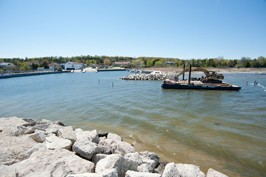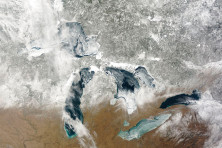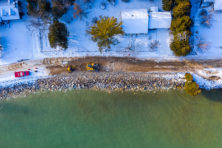Lake Levels Vary From Model to Model
- Share
- Tweet
- Pin
- Share

The town of Baileys Harbor has to dredge their marina each year, as low water levels contribute to the collection of sand within the harbor. Photo by Dan Eggert.
The water level’s low, and some climate models predict that it could get almost three feet lower.
Other models say the opposite – the lake could bounce back and rise above the long-term average level.
That creates a problem for coastal communities and property owners. Should they spend the money to dredge or wait? Do they risk potentially losing boat space, and hope lake levels rise?
“Uncertainty is the only certainty,” said Evan Murdock, surface water hydrologist and doctoral student at the University of Wisconsin-Madison.
Murdock presented on climate change impacts in Door County on Oct. 30 to a group of residents and municipal board members from throughout the peninsula. He went over climate models and predictions for Door County, which generally suggest there will be lower lakes, more summer storms, more heat waves and less snow.
But those are just models and predictions. Nobody can look into a crystal ball to see the definite future of Door County’s climate.
In the meantime, shoreline residents and communities dredge in attempts to get enough water under docks to store boats.
So far in 2012, the Department of Natural Resources has received 51 permit requests to dredge in Door County. That’s up from 47 last year and 19 in 2010.
“We have to do dredging every year until it gets back to where it was 11 years ago when I cut the ribbon to open the marina,” said Don Sitte, Baileys Harbor town chairperson.
The town cleaned the inside of the marina this fall to get rid of the collected rotten algae. In the spring, harbormaster John Hammarstrom said the town will dredge a channel from the marina into the harbor to clear a space for boats.
Low water levels only make the sand collection worse, Hammarstrom said. With a few more feet of water, the sand wouldn’t move as freely.
“With low water, being shallower, the wave action manipulates the bottom of the harbor more readily,” Hammarstrom said. “That’s what’s building up the sand.”
Mariah Goode, Door County planning director, invited Murdock to speak so towns could plan for uncertainty, like fluctuating water levels.
“It was supposed to be able to guide communities in decision making processes and think of what they can do to protect themselves,” Goode said. “There’s not going to be a definitive right answer because nobody knows what’s going to happen, so it’s more about raising awareness.”
Murdock suggested focusing on preparing for an uncertain future by building communities that can withstand whatever climate throws at them.
“Given what we know about how little we know, we need to be aware of what our key vulnerabilities are,” Murdock said. “If something unprecedented happens…you’re going to have some failures. You’re going to take some damage. What are those damages going to look like?”


